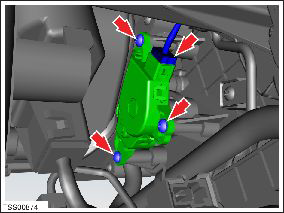Tesla Model S: Actuator - Front Passenger's Temperature (Remove and Replace)
Tesla Model S (2012-2025) Service Manual / Thermal Management / Actuator - Front Passenger's Temperature (Remove and Replace)
Removal
- Remove glove box assembly (refer to procedure)
- Disconnect duct temperature sensor harness connector.
- Remove screw securing duct to HVAC assembly, release from spigot
and position duct aside (torque 1 Nm).

- Disconnect actuator harness connector.
- Remove screws (x3) securing actuator to HVAC assembly (torque 1 Nm).
- Remove temperature control door actuator.
Caution: Take care not to damage component(s).

Installation procedure is the reverse of removal.
READ NEXT:
 Actuator - Defrost (Remove and Replace)
Actuator - Defrost (Remove and Replace)
Removal
Remove glove box assembly (refer to procedure)
Disconnect actuator harness connector.
Remove screws (x3) securing defrost door actuator to HVAC
assembly (torque 1 Nm).
 Motor - Fan assembly - HVAC (Remove and Replace)
Motor - Fan assembly - HVAC (Remove and Replace)
Removal
Power the passenger seat fully rearward for access.
Remove the passenger footwell closing trim (refer to procedure).
Disconnect the fan harness connector and position the
 Hose - HVAC - Drain (Remove and Replace)
Hose - HVAC - Drain (Remove and Replace)
Removal
Remove the LH closeout extension assembly (refer to procedure).
Note: For vehicles built with the cold weather
package between May 31, 2013 and July 11
SEE MORE:
 Headlining - Panoramic Roof (Remove and Replace)
Headlining - Panoramic Roof (Remove and Replace)
Removal
Remove front windshield (refer to procedure)
Lower headlining for access (refer to procedure)
With assistance remove headlining through front windshield
opening.
Remove rear map lamps from headlining.
 Trim - 'C' Post Upper - LH (Remove and Replace)
Trim - 'C' Post Upper - LH (Remove and Replace)
Removal
Open LH rear door.
Fold rear seat back forward for access.
Using a suitable tool carefully release clips (x4) securing 'C'
post trim to body.
Caution: Take care not to damage component(s).
© 2019-2025 Copyright www.tesms.org

